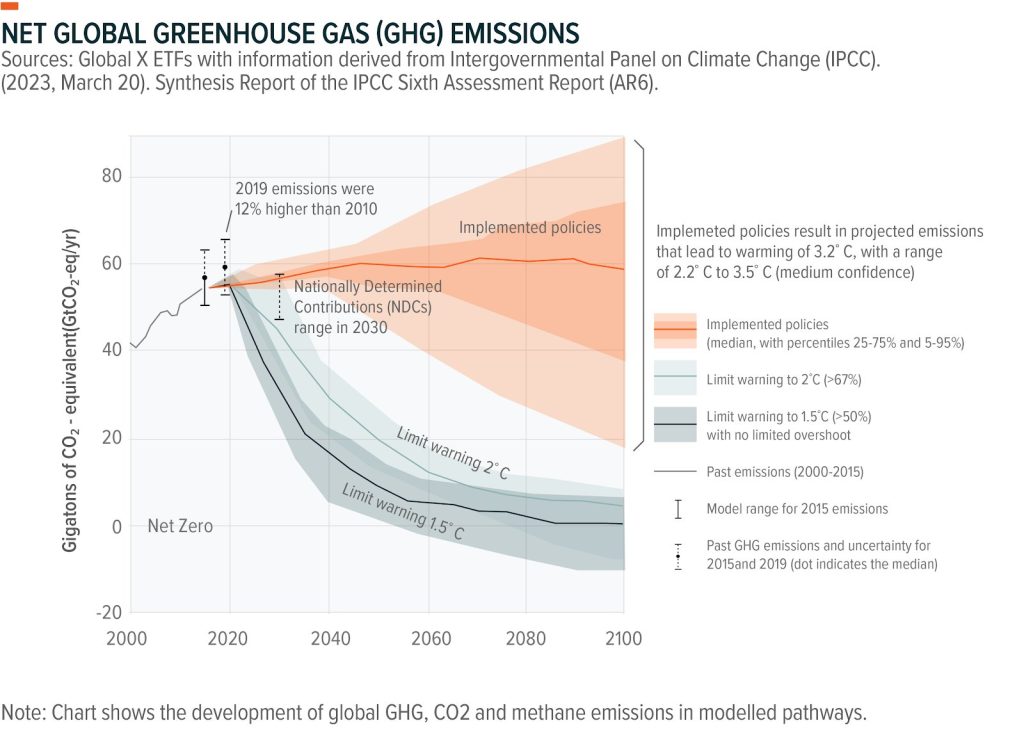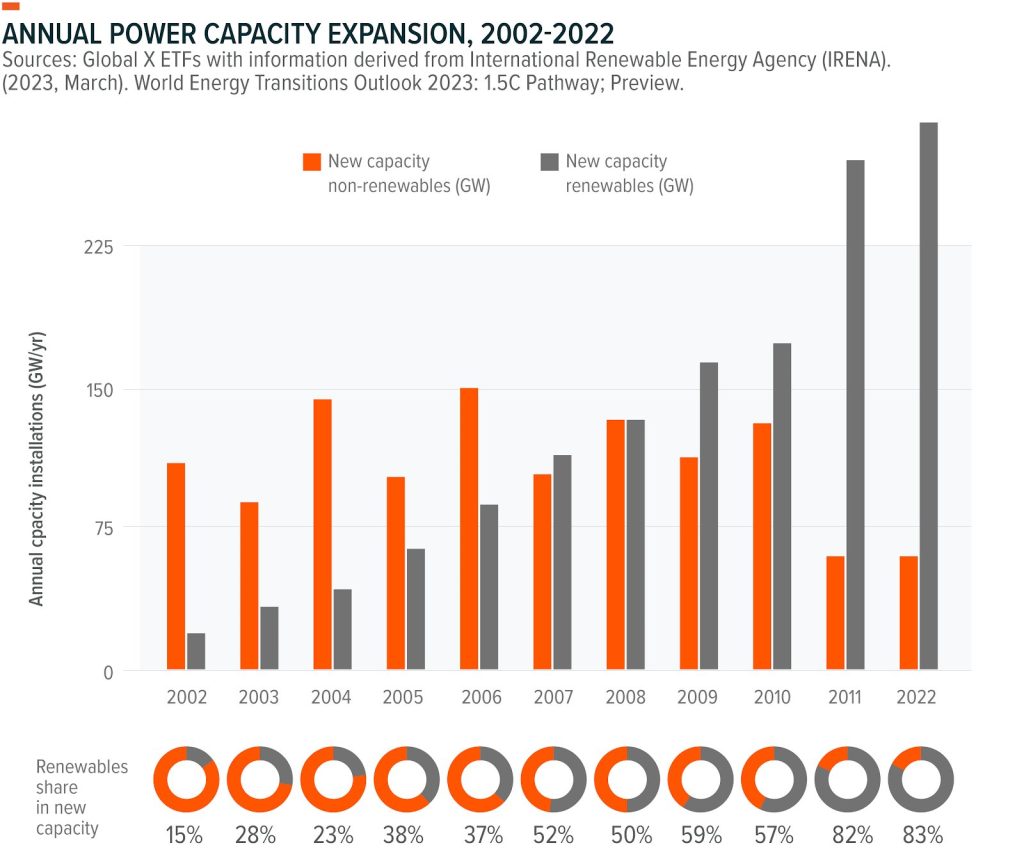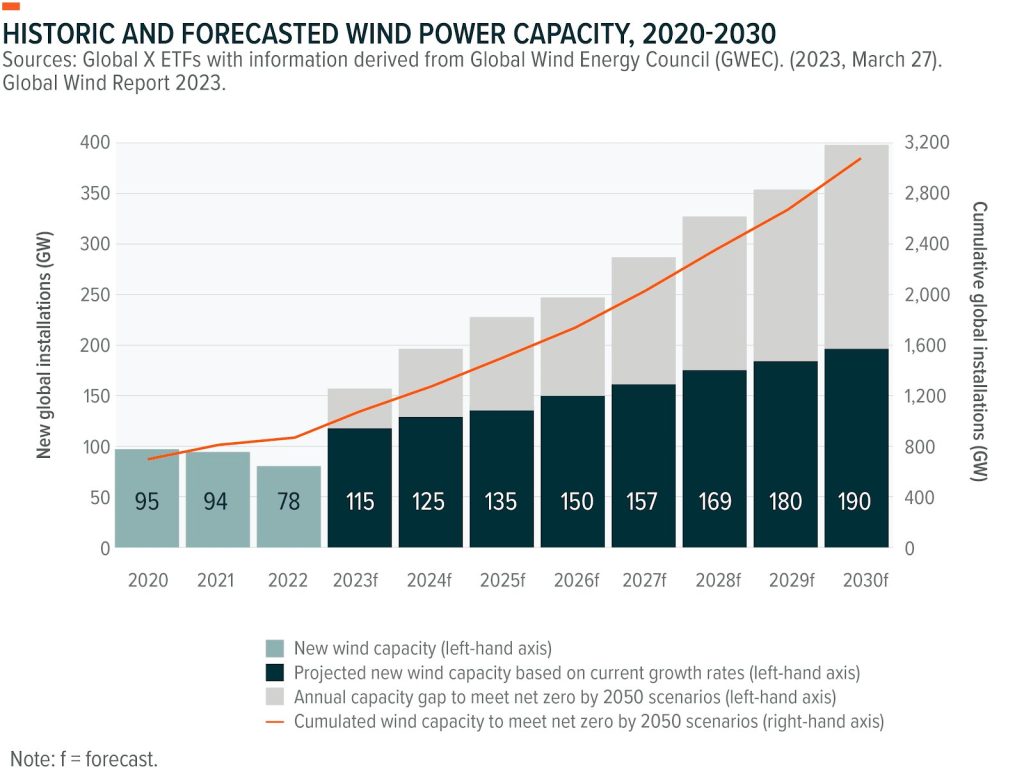By: Madeline Ruid, GlobalX
Three notable climate change and cleantech reports were published earlier this year: the Intergovernmental Panel on Climate Change (IPCC)’s final report in its current report cycle; the International Renewable Energy Agency (IRENA)’s World Energy Transitions Outlook 2023 Preview; and the Global Wind Energy Council (GWEC)’s annual report. In this piece, we provide summaries of the key findings that lay out the current state of climate change, discuss how the world can move to a more sustainable future through clean technologies, and offer our view on what this means for investors in clean energy themes.
Key Takeaways
- Immediate, deep, and sustained greenhouse gas (GHG) emissions cuts are required to limit the global average temperature increase to 1.5°C to 2°C warming targets.1
- To limit warming to 1.5°C, it is estimated that global investment across all energy transition technologies needs to reach $150 trillion by 2050.2
- While the wind power sector is likely to benefit from increasingly positive government policies, more investments are needed for the technology to stay on track with 1.5°C scenarios.3
IPCC Report: Rapid Decarbonization Can Limit Warming but Window of Opportunity is Narrowing
First, the UN IPCC report, titled AR6 Synthesis Report: Climate Change 2023, summarizes all the conclusions from the body’s Sixth Assessment Report cycle. UN Secretary-General António Guterres describes the report as “a survival guide for humanity.”4 It provides overviews for 1) the physical science of climate change, including climate projections, 2) the current and future potential impacts of climate change and how adaptation measures can minimize related risks, and 3) how climate change mitigation can limit warming and reduce the overall losses and damages. Summaries below:
The Physical Science: Human activities and the resulting rapid increase in greenhouse gas emissions “have unequivocally caused” Earth’s temperature to rise.5 The Earth’s average global surface temperature has already warmed 1.1°C when comparing 2011-2022 to the ‘pre-industrial’ time frame of 1850-1900.6 Looking forward, given current government policies, scientists now believe it is likely that the world could exceed the critical 1.5°C warming threshold, at least in the near term.7 Over the long term, the Earth’s average global surface temperature is forecasted to warm an average of 2.8°C-3.2°C by 2100, well above the 2°C target.8 While there is still a chance to limit warming to 1.5°C to 2°C, it requires “deep, rapid, and, in most cases, immediate” emissions cuts.9 The chart below shows how various emissions scenarios could impact global temperature change.

Potential Impacts & Climate Adaptation: The world is already experiencing adverse impacts from warmer temperatures. Future climate change is projected to increase the severity of impacts across both natural and human systems. This includes more extreme heat events, changes in precipitation patterns, increased health risks, melting glaciers and ice sheets, and rising sea levels, among others.10 As a result, we will need to adapt to changes to ecosystems, food systems, water availability, infrastructure, cities, and health systems.
Climate Change Mitigation: To have the best chance at keeping within the 1.5°C limit, it is forecasted that greenhouse gas emissions need to fall by 43% compared to 2019 levels by 2030, 60% by 2035, and 84% by 2050.11 Limiting warming to 2°C likely requires greenhouse gas emissions to fall by 21% compared to 2019 levels by 2030, 35% by 2035, and 64% by 2050.12 The IPCC report notes that we have the tools already available to reach net-zero CO2 and greenhouse gas emissions. These include low- or zero-carbon energy sources, such as renewables and fossil fuels with carbon capture and storage (CCS), energy and water use efficiency measures, electric vehicles, energy storage, biofuels, low-emissions hydrogen, public transport systems, green buildings, and sustainable agriculture practices. The report also notes that rapid and sustained mitigation could reduce projected losses and damages from climate change while delivering co-benefits, including improved air quality and health.13
IRENA: Limiting Warming to 1.5°C Creates Potential $150 Trillion Investment Opportunity in CleanTech
IRENA’s latest publication offers a preview of its full report that will come out later this year, titled World Energy Transitions Outlook 2023: 1.5C Pathway. The report is expected to show that while notable progress has been made on the clean energy transition, the current scale and extent of change is not enough to keep warming under 1.5°C, reaffirming the findings from the IPCC.14
In order to limit warming to 1.5°C, IRENA projects that the power sector would have to add 7,000 gigawatts (GW) of renewable electricity capacity by 2030, or an annual average of 1,000GW.15 For context, there are about 3,000GW of renewables globally today, and around 295GW were added worldwide in 2022.16 Renewables accounted for 83% of total capacity additions last year, as seen in the chart below.17

In order to accelerate the clean energy transition to stay on track, IRENA estimates that annual investments across all energy transition technologies need to quadruple from $1.3 trillion in 2022 to $5 trillion annually, on average.18 Over the long term, IRENA projects that global investment across all energy transition technologies needs to total $150 trillion from 2023 to 2050 to limit warming to 1.5°C.19 However, the current planned energy scenario, which is based off current governments’ energy plans, sees $103 trillion in investments between 2023 and 2050.20 This means that there is currently a $47 trillion investment gap. Over the medium term, IRENA estimates that $35 trillion of these clean energy investments must occur by 2030 to stay on track.21
IRENA notes that current investments are limited to a number of countries and a few technologies. Currently, most investments are going towards solar photovoltaic and wind power systems.22 However, more funding needs to flow to other clean technologies such as biofuels, hydropower, geothermal energy, hydrogen, and energy efficiency and heating systems. The chart below provides a breakdown of the planned energy scenario and 1.5°C scenarios, by technology.

GWEC: Wind Power Sector Likely to Rebound in 2023, Although Growth Must Accelerate to Reach Net Zero
The Global Wind Energy Council’s latest report reveals that 2022 was the third-best year for wind power capacity installations.23 Despite a range of headwinds such as supply chain challenges, higher materials and project costs, project delays, and the Russia-Ukraine conflict, 78GW were installed.24
Looking forward, the GWEC forecasts the wind power industry to rebound with 100 GW of new capacity in 2023, a projected 15% year-over-year (y-o-y) growth.25 Over the medium term between 2023 and 2027, the GWEC forecasts 680 GW of wind power capacity additions. Over the long term between 2023 and 2030, GWEC forecasts 1,078GW of new wind capacity additions, which represents a 143GW or 13% increase from last year’s forecast.26 The ongoing dual focus by governments on boosting energy security and mitigating climate change is one of the primary supporting factors for this year’s strengthened growth outlook. In particular, the report states, “governments of all major industrialized nations have enacted policies that will result in a significant acceleration of deployment.”27
That said, wind power growth needs to accelerate even more to stay on track for net-zero emissions and 1.5°C pathways. GWEC estimates that installations need to grow 5x from 2022’s cumulative growth to reach around 400 GW annually by the end of the decade, as depicted in the chart below.28

Also in the report, the GWEC warns of a potential impending wind power equipment supply crunch. In its view, spare capacity in the wind energy manufacturing landscape is “likely to disappear by 2026 unless urgent investment is made in the supply chain.”29
Conclusion: Much Work Remains to be Done, Although Potential Investment Opportunity Appears Large
While the clean energy transition is well underway and the policy environment has continued to improve, the growth of clean technologies must accelerate even more to limit warming to the 1.5°C-2°C thresholds and reduce risks. Limiting warming is forecasted to require substantial investments into the clean energy space, upwards of at least $150 trillion through 2050.30 Consequently, the investment opportunity appears massive. Companies throughout the entire cleantech industry, and related themes such as lithium and battery tech and disruptive materials, stand to potentially benefit. Climate change adaptation will also become increasingly important, which could benefit adaptation-focused themes such as agtech, green buildings, and clean water. Furthermore, cleantech supply chains must continue to expand, or they risk slowing down the transition. In our view, these reports serve as not just a call to action, but also as a reaffirmation of the likely positive long-term outlooks and robust tailwinds for clean technologies and other climate-change related industries.
Footnotes:
1. Intergovernmental Panel on Climate Change (IPCC). (2023, March 20). Synthesis Report of the IPCC Sixth Assessment Report (AR6).
2. International Renewable Energy Agency (IRENA). (2023, March). World Energy Transitions Outlook 2023: 1.5C Pathway; Preview.
3. Global Wind Energy Council (GWEC). (2023, March 27). Global Wind Report 2023.
4. Intergovernmental Panel on Climate Change (IPCC). (2023, March 20). Synthesis Report of the IPCC Sixth Assessment Report (AR6).
5. Ibid.
6. Ibid.
7. Ibid.
8. Ibid.
9. Ibid.
10. Ibid.
11. Ibid.
12. Ibid.
13. Ibid.
14. International Renewable Energy Agency (IRENA). (2023, March). World Energy Transitions Outlook 2023: 1.5C Pathway; Preview.
15. Ibid.
16. Ibid.
17. Ibid.
18. Ibid.
19. Ibid.
20. Ibid.
21. Ibid.
22. Ibid.
23. Global Wind Energy Council (GWEC). (2023, March 27). Global Wind Report 2023.
24. Ibid.
25. Ibid.
26. Ibid.
27. Ibid.
28. Ibid.
29. Ibid.
30. International Renewable Energy Agency (IRENA). (2023, March). World Energy Transitions Outlook 2023: 1.5C Pathway; Preview.
This post first appeared on June 1st, 2023 on the GlobalX blog
PHOTO CREDIT: https://www.shutterstock.com/g/Man+As+Thep
Via SHUTTERSTOCK
DISCLOSURE
Investing involves risk, including the possible loss of principal. Diversification does not ensure a profit nor guarantee against a loss.
This material represents an assessment of the market environment at a specific point in time and is not intended to be a forecast of future events, or a guarantee of future results. This information is not intended to be individual or personalized investment or tax advice and should not be used for trading purposes. Please consult a financial advisor or tax professional for more information regarding your investment and/or tax situation.

